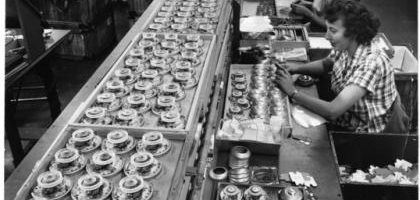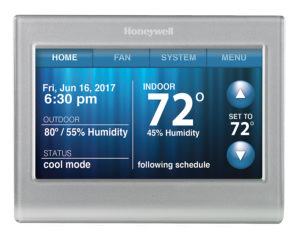The Fourth Industrial Revolution brings a Century-Old Company into the Era of Digitalization

Honeywell proves that being an American classic doesn't mean getting stuck with yesterday's technology.
“The First Industrial Revolution used steam power to mechanize production. The Second used electric power to create mass production. The Third used electronics and information technology to automate production. Now a Fourth Industrial Revolution is building on the Third. It is characterized by a fusion of technologies that is blurring the lines between the physical, digital, and biological spheres,” Professor Klaus Schwab, Founder and Executive Chairman of the World Economic Forum (1). This fourth industrial revolution, or digitalization, has had far-reaching, disruptive effects on companies around the globe. Some companies see opportunities, while others face challenges. For companies that have existed for a long time, the need to adapt is imminent.
Honeywell has its roots in the second industrial revolution, stemming from 1885 when Albert Buzz patented the furnace regulator and later invented the predecessor to the modern thermostat (2). Following a history of constant innovation, Honeywell is adapting quickly to the fourth industrial revolution by (1) developing breakthrough technologies; (2) reorganizing its operating units; and (3) acquiring companies with existing digital technologies.
Recognizing this shift, Honeywell has arguably become the leading industrial product provider in the internet of things (IoT) economy. They aim to transform the manufacturing industry, moving their competitive advantage from physical machinery to information at hand (8). These industrial IoT products, dubbed “IIoT by Honeywell,” focus on “smart manufacturing” and mitigate the risk of developing IoT products by diversifying the products across building automation, smart metering, and worker safety (3). Current products on the market and in development include:
- Honeywell Connected Worker-A mobile hub collects data from sensors to understand what a worker is experiencing at a given moment, pulling data from a heart-rate monitor, a breathing apparatus, a toxic gas monitor, and an activity detection device (4).
- Utility PRO Smart Thermostat-This residential thermostat includes features such as smartphone connection, wi-fi, an indoor humidity sensor, voice command, and wall-color matching ability (5).
- Enterprise Building Integrator-This program creates a more efficient building through energy, connectivity, and security (3). It can monitor HVAC, lighting, water, and electricity; collect data on energy consumption; provide access to security information and surveillance; and monitor fire detector systems (3).

- One Wireless Network- This network extends process control and is more efficient than wired solutions, allowing workers to access process data and plant information from the field (6).
- SmartLine Transmitters- These transmitters process data and communicate that data to the control room–displaying maintenance information, detecting tampering, and allowing operators to send messages to the display screen (7).
Through this transformation to the IoT economy, Honeywell is also reorganizing its structure to adapt to changing demand. In May 2016, the company announced that it would create a new division for IoT analytics known as the “Digital Transformation” division (9). This new division will collect data from Honeywell products, pool it together, and analyze it to provide the business with recommendations on how to improve efficiency and cut costs (9). It will also monitor devices for cybersecurity threats and manage those responses (9). Secondly, Honeywell announced in July 2016 that they would be splitting their Automation and Control Division into two different units, one focused on safety and productivity products and one focused on HVAC and fire-safety (10). Analysts speculate that this move signals that Honeywell is refocusing on technology and potentially selling its air conditioners, heaters, and fire systems business (10).
Honeywell has also acquired companies to develop new IoT technology. They have a history of sourcing new technology from acquisitions in addition to sourcing internally. Between 2008 and 2016, Honeywell acquired 16 companies (11). This acquisition of new technologies and digital product companies continues to build on their footprint in the IoT economy. Three recent acquisitions from summer 2016 include:
- Elster focuses on thermal gas solutions, including smart meters and data analytics (12).
- Intelligrated gives Honeywell access to warehouse automation solutions and software, aiming towards smarter distribution and fulfillment (13).
- JDA Software (deal did not close) would have expanded Honeywell’s supply-chain software footprint by helping retailers optimize their supply chains and monitor them (14).
While Honeywell has already established itself in the digital economy, there is one area where it could improve: aerospace. Aerospace is nearly as large a segment for Honeywell as its Automation and Controls division–35 percent of revenue compared to 40 percent–yet this division has seen very little in the way of digital innovation (15). The division manufactures airplane brakes, wheels, runway safety systems, auxiliary power units, and turbine engines. These could all be engineered to become IoT products so that airline mechanics, air traffic controllers, and airline operations employees can monitor the products to ensure safety and efficiency. This treasure trove of data could be very useful at understanding how to better design airplane parts and improve performance.
(800 words)
SOURCES
(1) https://www.weforum.org/about/klaus-schwab/
(2) http://www.honeywell.com/who-we-are/our-history
(3) http://www.fool.com/investing/general/2015/11/09/3-reasons-honeywell-international-inc-is-a-great-i.aspx
(4) http://www.honeywell.com/newsroom/pressreleases/2015/11/honeywell-and-intel-demonstrate-prototype-of-wearable-iot-connected-safety-solutions-for-industrial-workers-and-first-responders
(5) http://yourhome.honeywell.com/en/products/thermostat/wi-fi-smart-thermostat-rth9580
(6) https://www.honeywellprocess.com/en-US/explore/products/wireless/OneWireless-Network/pages/default.aspx
(7) http://www.honeywell.com/newsroom/pressreleases/2014/11/honeywell-s-latest-smartline-transmitter-increases-capabilities-of-smart-field-products
(8) https://www.honeywellprocess.com/en-US/innovations/Pages/iiot.aspx
(9) http://www.businessinsider.com/honeywell-creates-new-division-for-industrial-iot-data-and-analytics-internet-of-things-2016-5
(10) https://www.bloomberg.com/gadfly/articles/2016-07-25/honeywell-shake-up-could-a-make-breakup-easier-to-do
(11) https://www.crunchbase.com/organization/honeywell/acquisitions
(12) http://www.honeywell.com/newsroom/pressreleases/2015/07/honeywell-to-acquire-elster-a-global-leader-in-gas-heating-controls-metering-and-advanced-technologies
(13) http://www.honeywell.com/newsroom/pressreleases/2016/07/honeywell-to-acquire-intelligrated-a-leader-in-supply-chain-and-warehouse-automation-technologies
(14) http://etfdailynews.com/2016/08/15/report-honeywell-to-acquire-jda-software-for-3-billion/
(15) http://www.wikinvest.com/stock/Honeywell_International_(HON)
Cover Photo: https://www.minnpost.com/minnesota-history/2012/12/keeping-temps-just-right-minneapolis-developed-thermostat
Exhibit 1: http://yourhome.honeywell.com/en/products/thermostat/wi-fi-smart-thermostat
Exhibit 2: https://buildingsolutions.honeywell.com/en-US/solutions/intelligentbuildings/Pages/default.aspx




Cool post Parker. I wonder If aerospace lags behind the IoT curve due to security/safety concerns. Just like we can imagine a world with fully automated cars, we could imagine the same thing for airplane and air traffic controllers. The potential for disaster is just so much greater for airplane automation and connectivity. According to the IIHS, there are about 30,000 fatalities related to automobile accidents in the US each year , but only about 450 fatalities a year related to US airplane accidents, according to the NTSB. So, one automobile malfunction or hijacking could account for 2-4 deaths out of 30,000 and most likely would be more than made up for by the increases in overall safety from automobile automation. However, one airplane accident due to a malfunction or electronic hijacking would be absolutely disastrous, potentially equaling or exceeding the total death toll from airplane accidents for the entire year. I don’t see airplane/air traffic controller automation happening any time soon. I do, however, think that the pilot assist technologies have been a great addition to the industry and made flying safer.
http://www.iihs.org/iihs/topics/t/general-statistics/fatalityfacts/state-by-state-overview
http://www.ntsb.gov/investigations/data/Pages/AviationDataStats2014.aspx
Thanks for the post, Parker. I didn’t realize that the IoT market for aerospace had such tremendous potential. After looking at Honeywell’s recent investor presentation at the Gabelli Aircraft & Connectivity Conference, it seems that Honeywell has considerable opportunity in the space. Recent research shows that travelers prefer wi-fi to legroom and food offerings. There is also rapid adaptation with approximately 25,000 aircraft to be equipped with wi-fi by 2025 [1]. It also seems, an increased presence in China would present low hanging fruit, given that 47% of revenues are derived in the United States. The company sees substantial opportunities to capture the untapped Chinese market for infrstructure, digital economy, and vehicle emmissions / industrial VOC [2].
1. http://investor.honeywell.com/Cache/1500091104.PDF?O=PDF&T=&Y=&D=&FID=1500091104&iid=4121346
2. http://investor.honeywell.com/Cache/1500091500.PDF?O=PDF&T=&Y=&D=&FID=1500091500&iid=4121346